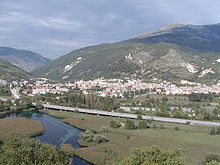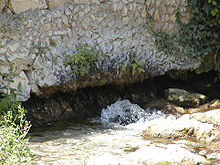Aterno-Pescara
![]()
This article is not sufficiently supported by evidence (for example, itemized). Information without sufficient evidence may be removed soon. Please help Wikipedia by researching the information and adding good evidence.
So far no sources are given at all. --DF5GO 22:42, 6 Aug. 2012 (CEST)
Pescara (Latin: Aternus) is a river in Italy. The length is 145 km. The river is navigable only at the mouth in the city of Pescara. The river first flows as the Aterno southeast through the province of L'Aquila, turns northeast above Popoli. Then the Gizio flows towards it, from here it is called Pescara. Here it breaks through the Abruzzo and forms the border between the provinces of Teramo and Chieti until it reaches the Adriatic Sea.
The "spring" with the name "Riserva Naturale delle Sorgenti del Pescara" is located on the road to Vitorito about 5 km from Popoli and is equipped as a recreational area with a large parking lot, children's playground and barbecue station. The actual spring area itself, which is somewhat distant, comprises a 49-hectare area from the karst spring, protected since 1986, with a lake in its dense reed belt, where the coot, heron and the rare kingfisher, among others, find shelter. It is also the last refuge of the brook lamprey in Italy, although the number of animals is dwindling year by year.
The reed bed used to be commercially exploited. Nowadays, since it is no longer allowed to be harvested, the lake is getting smaller and the various reed belts are getting bigger. The area is part of the largest bird sanctuary in Abruzzo and is the target of various ornithological studies. In this large area, in many places the water comes directly from the mountain slope or from the sandy subsoil in the lake.
Much of this spring water comes from the karstic plateaus of Campo Imperatore, the strikingly shaped mountain range in the Gran Sasso area, at altitudes ranging from 1600 to 2200 meters. From the precipitation in the mountains to the source, the surface water and the water just below the surface takes about a month. The deep water, due to the accident during the tunnel boring in the Grand Sasso, one of the underground lakes was bored, is stored in different lakes for more than 20 years until it emerges from the rock with more than 7000 liters per second.
In the summer of 2007, the driest for a long time, the spring areas around Popoli carried little water, more precisely the Callisto spring with about 1000 liters of water per second, so that there were impairments in the water supply of the cities of Pescara and Chieti. It is not yet known to what extent the various forest fires, in which a fire-fighting helicopter also had an accident, will affect the vegetation and thus also the spring water.
Various studies are in preparation, since the fires, some of them devastating, have devastated large parts of the natural park. In some cases they could be kept away from the localities only very narrowly, however, some farms and observation huts have been destroyed.
The lake can only be entered at a cleared spot and the area only on fenced hiking trails. If hikers are found outside these trails, they face severe penalties.
· 
On the right the river Pescara, on the left the river Aterno from L'Aquila
· 
The source lake, which is becoming smaller and smaller
· 
Spring water comes from the sandy subsoil
· .jpg)
Brook lamprey from the source lake

A view of the spring area and Popoli in the background

One of the sources at Popoli
Questions and Answers
Q: What are the coordinates of Aterno-Pescara?
A: The coordinates of Aterno-Pescara are 42°28′10.87″N 14°13′46.62″E / 42.4696861°N 14.2296167°E / 42.4696861; 14.2296167.
Q: Where does the Aterno-Pescara river start?
A: The Aterno-Pescara river starts as Aterno on the Monti della Laga, a mountain range in the central Apennines.
Q: How large is the watershed of this river?
A: The watershed of this river is 3,190 km2 (1,230 sq mi).
Q: In which provinces does it flow through?
A: The Aterno-Pescara flows mainly through the provinces of L'Aquila and Pescara; it also flows through Chieti but only for a short distance.
Q: Where does it join with another river?
A: In the comune of Popoli, the river is joined by the Pescara River.
Q: Where does it empty into?
A: It empties into the Adriatic Sea in the city of Pescara.
Search within the encyclopedia